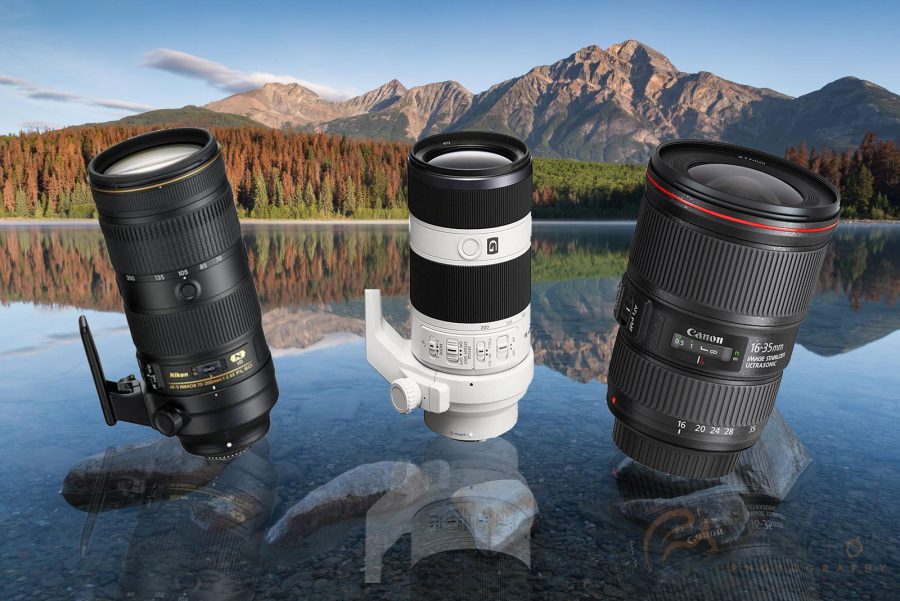8 Best Lenses for Landscape Photography in 2024

Choosing the right equipment for taking landscape photos is difficult, and gear advice is the number one question I get sent regularly. We’ve published a number of articles looking at the best lenses for landscape photography over the years, but companies are continuing to bring out new and improved equipment.
This article will look at my recommendations of the top lenses for landscape photography as of 2018, giving you up to date advice for choosing the right lens.


Recommended Lenses for Landscape Photos
The lenses you might consider for landscape photography come in three main categories:
- Wide-angle – the typical choice for landscapes, this style of lens will allow you to benefit from a wider field of view.
- Telephoto – a much less common choice for landscapes, a telephoto lens allows you to focus in on particular areas of a scene whilst compressing the scene in a 2D space.
- Standard lenses – these lenses tend to reflect what the human eye sees, hovering around the 50mm focal length mark.
Let’s take a look at some of the best choices across these three categories (not ranked in order):
#1 Canon 16-35mm f/4L IS USM
Considered to benefit from improved corner-to-corner sharpness when compared to its f/2.8 counterpart, the Canon 16-35mm f/4L IS USM lens is a force to be reckoned with. It’s a lens I have myself, actually, and I find that it covers the perfect focal length for shooting dynamic landscapes that take in the entire scene.

The lens also has built-in vibration reduction, something that I find very useful when trying to travel light.
#2 Sigma 14-24mm f/2.8 Art
Coming from Sigma’s latest Art range, these lenses promise extremely high quality and make up the best lenses created by Sigma. The 14-24mm f/2.8 Art lens from Sigma is available in Canon, Nikon, and Sigma mounts. It is a very wide lens, and a great choice for those who love to include huge vistas in their shots.
#3 Nikon 24-70mm f/2.8E VR
Before moving to Canon, done for the purposes of shooting video primarily over stills, I used to own the original Nikon 24-70mm f/2.8 lens. This was my “go to” lens for landscapes, and to this day it remains a very popular choice amongst landscape photographers.
Nowadays, it exists as a new and improved Nikon 24-70mm f/2.8E VR lens, meaning it has built-in vibration reduction. This is ideal for landscape photographers who like to “run and gun” without the burden of a tripod.
#4 Canon 24-70mm f/2.8L IS USM Mark II
Canon’s own answer to the 24-70mm, this lens is super sharp and sees minimal distortion across the image. It is a great lens that covers an ideal focal length range for landscape photography. Canon also make an f/4 version of this lens, for those looking to save some money.
#5 Canon 24-105mm f/4L IS II
Offering increased reach at the expense of a smaller minimum aperture, the Canon 24-105mm lens is definitely one you should consider too. This bridges the gap nicely between wide-angle and shorter telephoto lenses. You’ll be able to focus in on more specific areas of the shot with the 105mm end of the lens, whilst retaining wide-angle capability at 24mm.
#6 Sony FE 70-200mm f/4 G OSS
The Sony FE 70-200mm f/4 lens is a great choice for those shooting on mirrorless cameras who want to be inventive and use a telephoto in their landscape shots. The lens comes highly recommended, and is also a fantastic choice because it allows you to cross over into wildlife photography thanks to its long focal length.
#7 Nikon 70-200mm f/2.8E AF-S
Unfortunately a very pricey lens from Nikon, the 70-200mm remains tempting thanks to its high quality performance. This is another great lens for those looking to crossover between landscape and wildlife photography.
#8 Canon 70-200mm f/4 L IS USM Mark II
A brand new lens from Canon, the Mark II version of the Canon 70-200mm f/4 lens is a fantastic choice for landscape photographers. Cheaper than its f/2.8 counterpart, this is a great option for those who stick only to landscape photography. It allows you to venture into wildlife photography should you wish, but if you’re also a very keen wildlife photographer then it is worth considering the faster (and also new) Canon 70-200mm f/2.8 Mark III lens.
Choosing the Right Focal Length
As you can see, there are a number of lenses that can be chosen for landscape photography. The range of focal lengths available is both a blessing and a curse – they all provide different creative possibilities, but that means you have a difficult choice ahead of you!
I would recommend that all landscape photographers make sure that they have at least one wide-angle and one smaller telephoto lens (up to the 200mm mark) to allow for flexibility whilst out on a shoot. There will be plenty of times you’ll need either lens, so if you are serious about taking your shots to the next level then it is worth investing in the two.
What do you think?
What is your favourite lens for landscape photography? Let us know in the comments – perhaps there’s something we have missed!
Don’t forget to check out our recommendations for the best camera for landscape photography.










